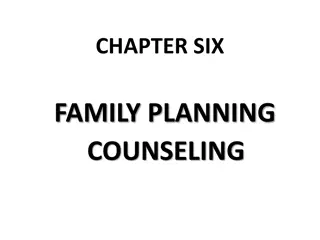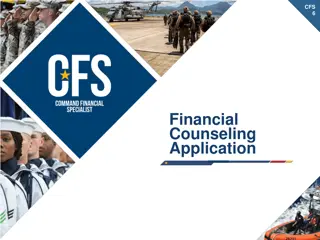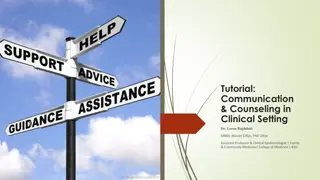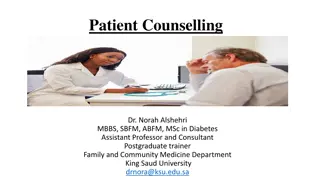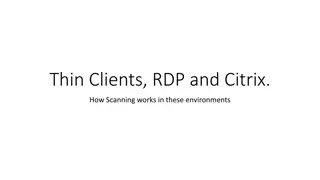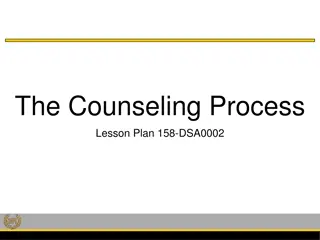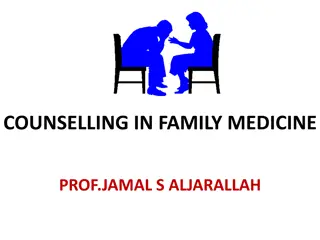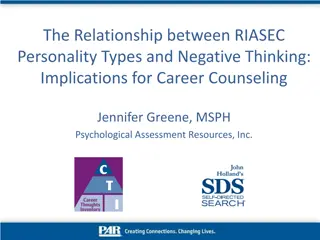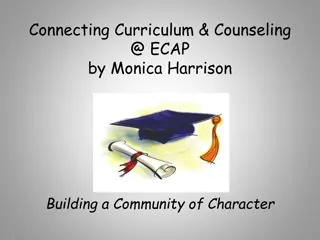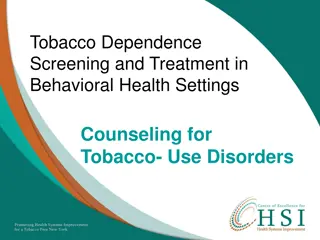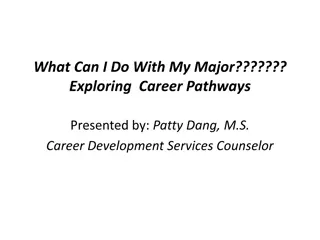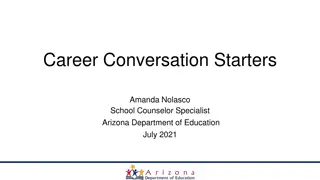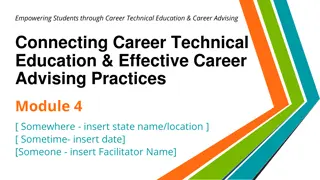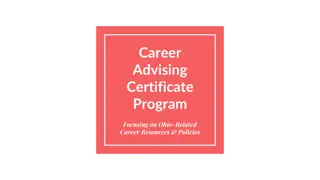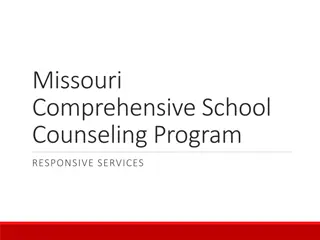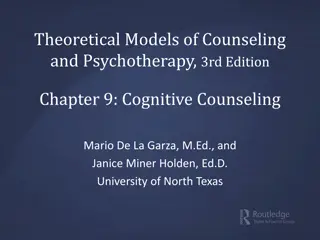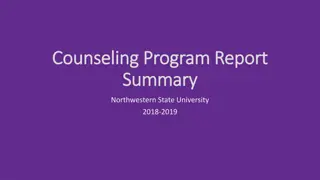Effective Strategies for Connecting with Clients in Career Counseling
Karen James Chopra, a seasoned career counselor and therapist, shares her insights and experiences in attracting and retaining clients for career exploration, job search, and career management. She discusses her Integrative Career Counseling model, background in trade negotiations, and dedication to helping career professionals establish successful private practices. Discover valuable tips for the intake process, client retention, and fostering meaningful connections in counseling sessions.
Download Presentation

Please find below an Image/Link to download the presentation.
The content on the website is provided AS IS for your information and personal use only. It may not be sold, licensed, or shared on other websites without obtaining consent from the author. Download presentation by click this link. If you encounter any issues during the download, it is possible that the publisher has removed the file from their server.
E N D
Presentation Transcript
CONNECTING WITH CLIENTS First Contact Through First Session
KAREN JAMES CHOPRA LPC, MCC, NCC Karen@TheSavvyCareerCounselor.com www.TheSavvyCareerCounselor.com (202)466-6979
KAREN JAMES CHOPRA BIO I am a career counselor and therapist with 14 years experience in private practice in Washington D.C. My business depends on attracting and keeping clients, so I have devoted much thought and attention to the particular challenge of the intake process. My clients come to me for help in three main areas: career exploration, job search and career management. In addition to my work with clients, I have a small consulting practice for career professionals, where I provide training and individual consultation services, especially for counselors and coaches looking to start or expand a private practice. I developed the Integrative Career Counseling (ICC) model to provide a framework for incorporating mental health approaches into career counseling. Prior to getting my masters in Community Counseling, I spent more than a decade working on trade negotiations for the U.S. Department of Commerce and the Office of the U.S. Trade Representative. That experience helped inform the first book I wrote: Coaching Career Clients through Salary and Other Workplace Negotiations. I am a regular presenter at regional and national conferences, particularly the National Career Development Association's annual conference. I was honored this year to be named the "Outstanding Career Professional" by the Maryland Career Development Association. You can find me on the web at www.TheSavvyCareerCounselor.com, and follow me on Twitter: @ChopraCareers.com
WEBINAR FUNDED BY THE U.S. DEPARTMENT OF LABOR This product was funded by a grant awarded by the U.S. Department of Labor s Employment and Training Administration. The product was created by the grantee and does not necessarily reflect the official position of the U.S. Department of Labor. The Department of Labor makes no guarantees, warranties, or assurances of any kind, express or implied, with respect to such information, including any information on linked sites and including, but not limited to, accuracy of the information or its completeness, timeliness, usefulness, adequacy, continued availability or ownership.
THREE STEPS FOR A NEW CLIENT First Contact First Session Setting an appointment First Call Website So much to do!!
TWO KEYS TO CONNECTION Manage the brain-based process of connection Facilitate new learning for the client: Aha!
In my experience, if a client learns something new about herself, she will come back. Anne Gray FACILITATING THE AHA MOMENT
NEW LEARNING Seeing patterns I always do this Locating oneself in the process That s where I am in my search Normalization I m not alone/I m not crazy Discovering resources Maybe I can do this Getting a new perspective Isn t that interesting? Seeing new possibilities I hadn t thought of that Finding help I don t have to do this alone
You dont just need their mind, you need to engage their brain and the brain is a social organ MANAGING THE EMOTIONAL PROCESS OF CONNECTION
WHEN THE EMOTIONAL BRAIN TAKES OVER: Frontal Lobes Shut Down As Emotional Activation Increases
EMOTIONAL SYSTEMS IN A POSITIVE LOOP Anxious Client Calm, curious counselor Client feels safe Counselor models openness Client relaxes
EMOTIONAL SYSTEMS IN A NEGATIVE LOOP Anxious Client Anxious Counselor Client withdraws Counselor works harder to win over client Client gets defensive
Taking care of business while managing the emotional process AND facilitating an Aha! Moment THE CONNECTION CHALLENGE
WHAT A WEBSITE SHOULD DO Provide information about you, your process, your qualifications, your specialties Make the client feel calmer and more hopeful Generate an aha moment for the client Make it easy for the client to see himself in your practice Make it easy to contact you
WEBSITE MISTAKES Written in the 3rdperson feels distant, impersonal Focus is on the counselor/coach and qualifications Armored websites are written with a defensive focus here s why I m good because it s written to protect our insecurities. Too arid not enough information for the client to connect Not enough internal linkages allows clients to follow their own path through the information.
CONNECTING VIA THE WEBSITE Use 1stperson to start the connection process. Talk to the client via the website. Include a picture Put contact buttons on each page Set up an Aha moment with rich content Checklists Common problems Services Blogs, articles, newsletters Favorite books, blogs, links Resources lists Video if you have it
Reach out and touch someone FIRST PHONE CALL
MAXIMUM RETURN, MINIMUM TIME Get a quick summary of what the client wants help with rephrase (Possible aha ) Tell the client how you will work with him/her (Possible aha ) Answer any questions (Possible aha ) Provide pricing info, even if not asked Schedule the appointment
BRIDGE TO THE FIRST SESSION Use forms and documents to continue the connection process: Informed consent Data forms Checklists Questionnaires Assessment Instruments Reading Other assignments
CHALLENGES Paperwork informed consent etc. First meeting jitters Divergent expectations Emotionally activated client Getting oriented Getting started Institutional policies/procedures Time limits
FACILITATING AN AHA MOMENT Get client to do most of the talking: What questions do you have? If we are successful in our work, what will have happened? Tell me about: family history, career history, what you have done so far Offer thoughts/interpretations in small chunks, then check. Recalibrate as necessary. Do/review short assessments Check at end: How did this meet your expectations?
PERSONAL FAVORITES Family history Family Genogram/Career Genogram 9 Lives Likes/Dislikes chart MBTI maybe Integrative Career Counseling approaches emotion and patterns of thought, feeling, and behavior
PREPARE FOR THE SECOND SESSION Confirm that client wishes to schedule another session. Provide an assignment to continue the connection process Make assignments easy and short prevent client discouragement OR Give client lots of assignments if they ask Set up another Aha moment Tell client you ll be asking about epiphanies, questions and reactions.
TECHNIQUES FOR MANAGING THE EMOTIONAL CONNECTION Understand everyone can be intimidating Call it like you see it describe the pattern Use your body language to modulate responses What personality types are most challenged by you? Get the problem out on the table where it can be addressed



